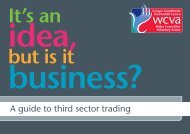Measuring Impact - Nicva
Measuring Impact - Nicva
Measuring Impact - Nicva
Create successful ePaper yourself
Turn your PDF publications into a flip-book with our unique Google optimized e-Paper software.
<strong>Impact</strong> assessment involving users 41<br />
6.2.2 Stage two: Using interviews to develop thematic areas<br />
In order to identify the characteristics and indicators of impact, an interview-based approach<br />
was used. From the organisations identified in stage one using the system map, a further<br />
group of voluntary sector service providers was recruited for interview. Their selection was<br />
not random, but based on their relevance to the beneficiary group and their understanding of<br />
the impact experienced by service users.<br />
These organisations in turn were asked to identify interviewees who had benefited from the<br />
activities of a wide range of voluntary sector service providers. Selection was again not<br />
random, but based on their engagement with the organisation and its activities. After refusals<br />
and cancellations, interviews were conducted with a diverse group of 21 service users.<br />
Other related service provider organisations<br />
EMEC works with recent arrivals within the context of other major service providers from<br />
the voluntary sector. The following are the other key providers whose service users were<br />
interviewed in this study:<br />
• New Futures Inclusion Partnership (NFIP) is an independent project set up by<br />
EMEC in partnership with other key providers that services ethnic minority individuals<br />
with alcohol or drug addictions. As the organisation’s staff shares office space and is linemanaged<br />
by EMEC, the two organisations work very closely.<br />
• Positive Action in Housing assists ethnic minority and refugee communities to overcome<br />
homelessness, racial harassment and poor housing through a casework/advocacy<br />
service.The organisation sometimes takes on trainees from EMEC under Positive Action<br />
in Housing’s Path project.<br />
• San Jai Project aids and advises Glasgow’s Chinese community and asylum seekers who<br />
speak Chinese languages.<br />
• The Meridian Black and Ethnic Minority Women’s Project provides courses, respite<br />
and development for Glasgow’s ethnic minority women over a wide range of ethnic minorities.<br />
These interviews started with the question “what are the needs of service users that are met<br />
by voluntary organisations” We were particularly interested in the different perspectives of<br />
what impact might be. When designing the interview schedule our starting point was a framework<br />
for these different perspectives: 13<br />
• Structural system: the interviewee’s view of how the activity works in terms of<br />
inputs, outputs and outcomes, as well as who is involved in the activity.<br />
• Political system: the role of power relations and levels of self-determination in these<br />
activities. How does the interviewee see their role in relation to others<br />
• Social system: group activities, and how they impact on people’s relationships.<br />
• Cultural system: the interviewee’s feelings about the value systems, ethics and<br />
knowledge of the organisation.<br />
13 These four perspectives are loosely based on Checkland’s (1990) three streams of enquiry in the tasks of ‘finding<br />
out’ the problem situation in his description of Soft Systems Methodology.












